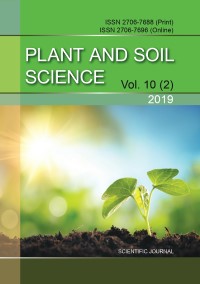Effect of seed inoculation and fertilizing on common beans productivity
DOI:
https://doi.org/10.31548/agr2019.02.022Keywords:
common beans, variety, mineral fertilizers, inoculation, Rizobofit, yield, protein contentAbstract
Common beans – valuable high-protein crop, has a multilateral use in the national economy. Expansion of industrial production of common beans is due to the growing demand for it on domestic and global market.Most part of grain of this crop is grown in the private sector at small areas (mainly at household plots), does not meet demand for its products, so there is a question about sown areas increasing. Purpose of research was to establish peculiarities of common beans productivity formation varieties Mavka, Perlyna, Nadiia, depending on doses of mineral fertilizers and seed inoculation on sod-podzolic soils of Transcarpathia of Ukraine.The experiment was laid on collection-demonstrative field of PE NULES of Ukraine Mukachevo Agrarian College in Transcarpathian region. Results of research allowed establishing that seed inoculation provided an increase in grain yield from 1,3 to 16,3%, depending on variety and fertilizers. It is noted that the higher was dose of fertilizer application, the lower was percentage yield of beans increasing due to inoculation.Application of mineral fertilizers in dose N90P60K30 without seed inoculation promoted an increase in yield of beans to 2,34 t/ha for variety Mavka, 2,45 t/ha for variety Perlyna and 2,15 t/ha for variety Nadiia. With inoculation of seeds by Rizobofit, yield of beans was higher for fertilizer application in dose N60P40K20 and reached 2,54 t/ha for variety Mavka, 2,63 t/ha for variety Perlyna and 2,36 t/ha in variety Nadiia. Nitrogen nutrition influenced on increasing protein content in the grain of studied varieties of common beans.Variety Nadiia was characterized by high palatability and quantity of protein in the grain, content of which on average over the years of research varied within 24,9-27,4%.References
Shliakhturov, D. S. (2008). The yield of ordinary beans depends on growing technology and weather conditions. Collection of scientific works of NSC «Institute of Agriculture UAAS», 3–4, 85–89.
Kaminskyi, I. V. (2013). Potential capacity of the domestic market of leguminous crops in Ukraine. Bulletin of the Sumy National Agrarian University. Series «Finance and Credit», 1, 101-108.
Ovcharuk, O. V. (2006). Features of the formation of bean crop depending on the timing of sowing and varieties in the conditions of the southern part of the western forest-steppe of Ukraine. Zbirnyk naukovykh prats Podilskoho derzhavnoho ahrarno–tekhnichnoho universytetu. [Collection of scientific works of the Podilsky state agricultural and technical university]. 14. 129–131..
Nosenko, Yu. (2015). Commodity Growing Common Beans. Agribusiness today .9 (304). Available at: http://agro–business.com.ua/agronomiia–siogodni/3238–tovarne–vyroschuvannia–kvasoli–zvychainoii.html
Maslak, O. (2015). The attractiveness of beans. Agribusiness today, 9 (304). Available at: http://www.agro–business.com.ua/ekonomichnyi–gektar/3047–pryvablyvist–kvasoli.html
Which niche crops are beneficial to grow in 2018. Agro News. Holovni ahrarni novyny. [Agro News. The main agrarian news.]. 29.03.2018. Retrieved from https://agronews.ua/node/89445
Doktor N. M., Novytska N. V. & Martynov O. M. (2018). Optimization of the technology of cultivation of common beans in the conditions of Transcarpathia. Tsili staloho rozvytku tretoho tysiacholittia: vyklyky dlia universytetiv nauk pro zhyttia. [The goals of sustainable development of the third millennium: challenges for life sciences universities: materials of the International Scientific and Practical Conference]. May, 23-25, Kyiv : National University of Life and Environmental Sciences of Ukraine, 226-227.
Dospekhov, B. A. (1985). Metodika polevogo opyta (S osnovami statisticheskoy obrabotki rezultatov issledovaniy) [Methods of field experience (With the basics of statistical processing of research results)]. Moscow: Agropromizdat, 351
Downloads
Published
Issue
Section
License
Relationship between right holders and users shall be governed by the terms of the license Creative Commons Attribution – non-commercial – Distribution On Same Conditions 4.0 international (CC BY-NC-SA 4.0):https://creativecommons.org/licenses/by-nc-sa/4.0/deed.uk
Authors who publish with this journal agree to the following terms:
- Authors retain copyright and grant the journal right of first publication with the work simultaneously licensed under a Creative Commons Attribution License that allows others to share the work with an acknowledgement of the work's authorship and initial publication in this journal.
- Authors are able to enter into separate, additional contractual arrangements for the non-exclusive distribution of the journal's published version of the work (e.g., post it to an institutional repository or publish it in a book), with an acknowledgement of its initial publication in this journal.
- Authors are permitted and encouraged to post their work online (e.g., in institutional repositories or on their website) prior to and during the submission process, as it can lead to productive exchanges, as well as earlier and greater citation of published work (See The Effect of Open Access).

